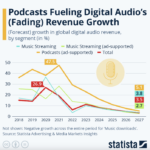 Traditional media and business models are fast making way for digital platforms as users spend increasing amounts of time online and consume more on-demand content. While mainstream television continues to enjoy the lion’s share of marketing budgets in South Africa, digital’s slice is fast growing larger than other channels. Paul Coetzer, Strategic Director at Platinum Seed looks at how to build a digitally-led business strategy.
Traditional media and business models are fast making way for digital platforms as users spend increasing amounts of time online and consume more on-demand content. While mainstream television continues to enjoy the lion’s share of marketing budgets in South Africa, digital’s slice is fast growing larger than other channels. Paul Coetzer, Strategic Director at Platinum Seed looks at how to build a digitally-led business strategy.
According to the PwC Entertainment and Media Outlook 2016-2020, total advertising revenue is forecast to increase from R43.3 billion in 2015 to R52.9 billion in 2020, a compound annual growth rate (CAGR) of 4.1%.
During this period, newspapers will fall 2.6% while the Internet will experience a CAGR of 16.9%.
Radio, Cinema and TV will grow by 4%, 6.4% and 4.1% respectively, while other segments such as out-of-home, magazines and B2B will grow marginally, in the low single digits.
While television is likely to retain at least a third of the overall pie, online ad spend growth, coming off a historically low base, is accelerating. By 2020, online’s share will grow to surpass that of B2B, cinema, magazines, newspapers, out-of-home and radio.
The Internet is already transforming how people plan and live their lives, from their travel, to their education, shopping and business. Industries such as retail, that previously thrived in purely brick-and-mortar spaces, will find it ever more difficult to compete without a strong e-commerce offering.
This became apparent when South Africa’s oldest retail chain, Stuttafords, shut its doors this year. While some observers say the 159-year-old retailer was merely a victim of an economic slump, others point to its failure to implement a strong digital business strategy, among other things, as a contributing factor.
Bridging the gap
Large gaps in digital investment exist between various sectors, and between different companies within the same sector.
However, digital “investment” is only the beginning – there are also huge gaps in terms of the level to which organisations use their existing digital assets and data to optimise transactions and interactions with customers, streamline business processes, and help employees work more efficiently.
Key sectors
It is difficult to find a sector that would not benefit from implementing a digitally-led strategy. However, comprehensive digital solutions are best suited for sectors where technology can drive efficiencies through automation or optimisation of business processes, or where data can give insights into customer behaviour and preference.
A study published in the Harvard Business Review in April 2016 scrutinised 27 key indicators of digitisation across industries in the US.
The study found that the IT sector (naturally) led the way in terms of digital investment and usage. Knowledge-intensive sectors such as media, professional services (engineering, legal, health) and finance/insurance are also proving highly innovative.
In these sectors data can offer insights into optimising business processes or customer behaviour and preference:
- Knowledge-intensive sectors (traditionally “professional” sectors such as law, architecture, engineering, accounting, health) can use content marketing in the form of blogs and online articles to attract new customers. Here, specialists write helpful content pieces on specific topics for users to search and read.
- Sectors that benefit from customising the marketing experience for different segments (retailers, cell phone companies, and the automotive industry) can use customer data to recommend relevant solutions to different customers.
- Companies using online channels to facilitate purchases, including online retailers and airlines, can use “remarketing” techniques to influence purchase decisions.
- Brands operating in legislatively restrictive sectors (e.g. alcoholic beverages or pharmaceuticals) can use social media channels to have direct conversations with customers.
- FMCG companies and retailers can incentivise purchases to drive customers in store by offering discounts deployed through mobile vouchering.
- Sectors that enjoy long term relationships with customers (such as financial institutions) can make use of specialised CRM software to organise, automate, and synchronise customer interaction, and customised digital CRM tools to measure consumers’ influence.
What is a digital-led strategy?
Developing a successful digital strategy takes more than knowing which technology to use.
Whether it’s a business, customer relations or marketing strategy, a digital-led strategy is focused on integrating digital technologies (web, social, mobile, and analytics) to transform how the business works, how it reaches its customers, and how it takes its products and services to market.
Organisations that embrace digital technology, develop and implement digital-led strategies with the objective of transforming the entire business. The focus is less on the actual technology and more on how the technology can create better efficiency using a range of tools.
At the very least, organisations that might be more resistant to digital change could use individual channels and technologies to fulfil specific strategies that are more operationally focused.
A successful digital-led strategy should be considered from the outset and fully integrated into the overall strategy. It isn’t added as an overlay to an existing strategy or translated from traditional strategy – it is the strategy.
Driven by data, a successful digital-led strategy is ever evolving and allows for investment and efforts to be adjusted and moved around to maximize ROI.
Leadership buy-in
A vital success factor is that the strategy be driven from the top, with buy-in at the highest levels of the organisation – a single person or group must lead the effort.
This person or group is not necessarily a digital specialist, but should be empowered and able to clearly articulate the value of digital technologies in the organisation’s success.
Ensuring that technology and digital specialists are represented at board level creates the right business culture for innovation to thrive.
Stick to fundamentals
There are no hard and fast rules in terms of when to lead with a digital strategy, or where implementing a digitally-led strategy will work best.
The same variables one would look at when formulating a “traditional” strategy need to be considered. For instance, the organisation’s mission statement, business objectives, budgets, target market preference, and route to market all need to be considered in relation to what technology can facilitate.
There is no longer a difference between a marketing strategy, customer strategy, communication strategy and a digital strategy. Business strategy and digital strategy are the same thing – and organisations are doomed to fail without them.
- MRF Unveils Latest MAPS® Data - 20th February 2025
- The BRC announces changes to the board and updates for 2025 - 17th December 2024
- Top 50 DSTV TV programmes – October 2024 - 12th November 2024





